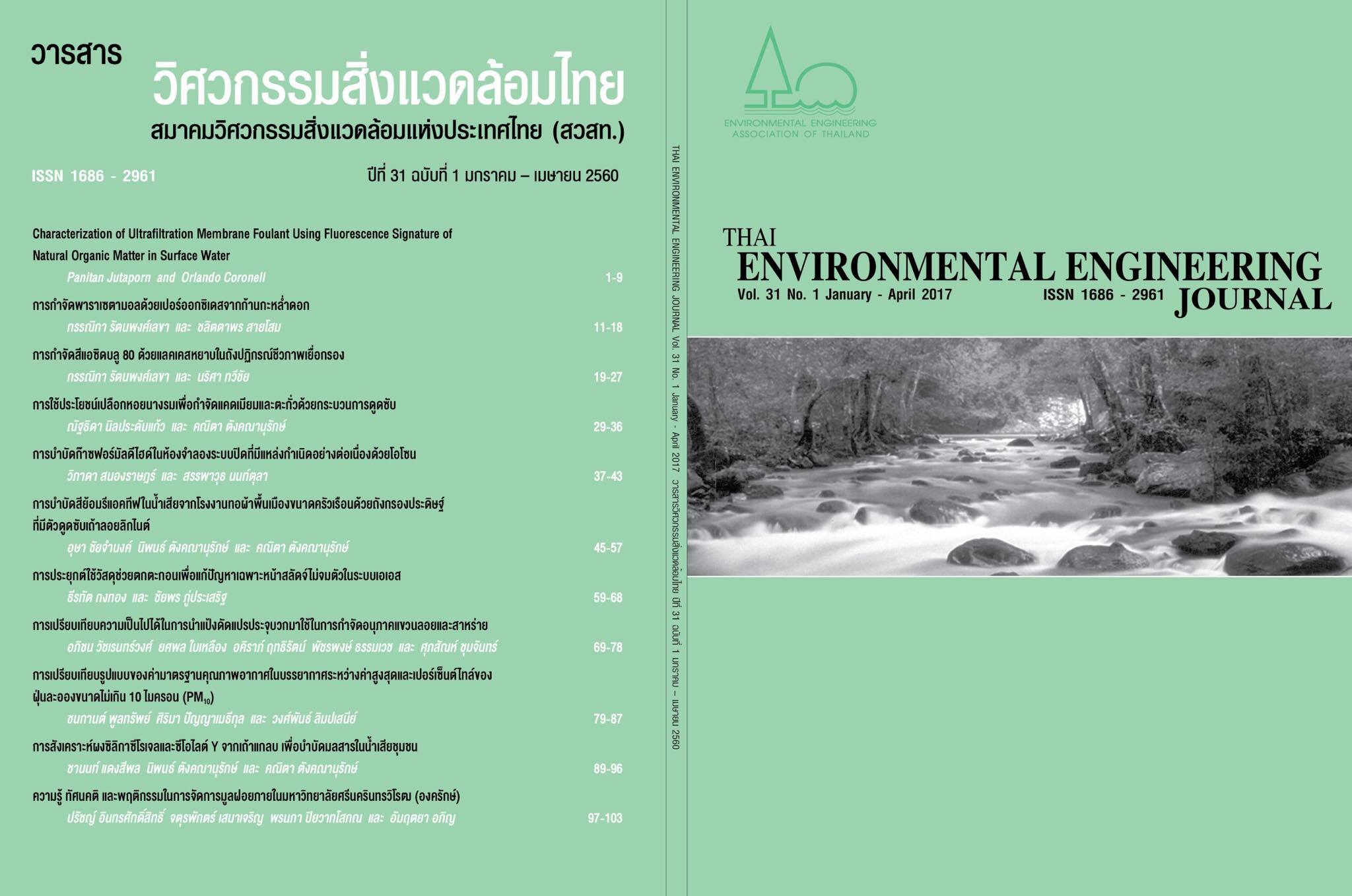Treatment of Reactive Dyes in Wastewater from Native Textile House-Hold Factory by Using Constructed Filter Tank with Lignite Fly Ash Adsorbent
Main Article Content
Abstract
The discharge from native textile factory can cause aquatic environmental problems because of residual reactive dyes. This research aims to create constructed filter tank which containing lignite fly ash adsorbent for removing nine reactive dyes (Yellow LS-R2, Yellow LS-4, Orange HF-2R, Red LS-B, Black R, Blue LS-3R, Navy LS-G, Blue G and Turquoise H-GN). Batch experiments were conducted to determine the optimum condition and adsorption potential of 3 absorbent materials (FA1 FA2 and FA3) were received from lignite coal combustion with various proportion of biomass at 90:10, 70:30 and 100:0 respectively. It was found that all of FA had averaged efficiency to remove dyes at 96.40%, 97.14% and 97.85% respectively, The average adsorption capacity were 0.96, 0.97 and 0.98 mg-dye/g-FA respectively. The adsorption mechanism was conformed to Langmuir isotherm and Freundlich isotherms. The column experiment was carried out by packing PVC tube with lime stone, coconut charcoal and FA mixed with coarse sand from top to bottom. The breakthrough point and exhaustion point of FA3 were highest at 29 and 37 L of synthetic wastewater respectively. The constructed filter tank had average removal from synthetic wastewater and textile factory wastewater were 97.09% and 96.98% respectively. The breakthrough points were 90 and 85 L respectively and the exhaustion points were 145 and 140 L respectively. Therefore, this constructed tank had a good potential on removal of reactive dyes residue content in wastewater from textile factory and could be applied to a large scale.
Article Details
References
go.th/images/stories/notices/pdf/tisi740_54.pdf, 21 February 2016. (in Thai)
[2] Gian, G. and T. Norca. 1998. Use of fly ash in reducing toxicity of and heavy metals in wastewater effluent. Hazardous Materials. 57: 243-248.
[3] APHA, AWWA. and WEF. 2005. Standard Methods for the Examination of Water and Wastewater, 21st edition, American Public Health Association, Washington, DC.
[4] Pavel, J., Buchtova, H. and Ryznarova, M. 2003. Sorption of dyes from aqueous solutions onto fly ash. Water Res. 37: 4938-4944.
[5] Waraporn Sittinang. 2012. Preparation of adsorbent material from mixture of bottom Ash and FGD gypsum for dye adsorption, Master Thesis, Chiang Mai University. (in Thai)
[6] Nipon Tangkananuruk and Kanita Tangkananuruk. 2007. Principles of Chemical Water Quality Analysis, 1st Edition, University Press. Agriculture, Bangkok.
(in Thai)
[7] Manickam, M. and Karunanithi, T. 2007. Adsorption of Chrysoidine R by using fly ash in batch process. J. Hazard. Mater. 145: 154-161.
[8] Shaobin, W., Boyjoo, Y., Choueib, A. and Zhu, Z.H. 2005. Removal of dyes from aqueous solution using fly ash and red mud. Water Res. 39: 129-138.
[9] Saakshy, K., Singh, Gupta, A.B. and Sharma, A.K. 2016. Fly ash as low cost adsorbent for treatment of effluent of handmade paper industry-Kinetic and modelling studies for direct black dye. Journal of Cleaner Production. 112: 1227-1240.
[10] Richards, P. and Reynolds, T. D. 1995. Unit Operations and Processes in Environmental Engineering, Second printing, Cengage Learning, Boston.
[11] Apisit Netrawong. 2009. Removal of Dyes from Textile Wastewater Using Lignite Fly Ash, Master Thesis, King Mongkuts Institute of Technology Thonburi. Bangkok. (in Thai)
[12] Pollution Control Department, Standard for Drainage Control of Industrial and Industrial Estate No. 3 (1996), Source: http://www.pcd.
go.th/info_serv/reg_std_water04.html, 18 August 2016. (in Thai)
[13] Maria, V., Bogatu, C. and Duta, A. 2010. Simultaneous adsorption of dyes and heavy metals from multicomponent solutions using fly ash. Appl. Surf. Sci. 256: 5486-491.


